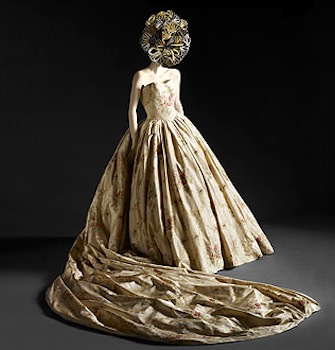
If you’ve opened a fashion magazine over the past fifteen years or so, you’ve probably seen an advertisement for Estée Lauder Pleasures. The “face” of pleasures has changed from time to time: actress Gwyneth Paltrow and model Carolyn Murphy, as well as numerous adorable puppies, have appeared in Pleasures ads since the fragrance was launched in 1995.
In the late 1990s and early 2000s, Elizabeth Hurley was the embodiment of this best-selling sheer floral. For an ad published in 1999, Hurley posed on a swing in a forest or garden blooming with pink and white flowers (appropriately chosen to suggest the fragrance’s composition of peonies, lilies, roses, and green notes).
Hurley’s strapless, full-skirted gown was created for the ad campaign by Elizabeth Emanuel, who had been one of the designers behind the iconic wedding gown worn by Diana, Princess of Wales in 1981. (This dress is currently featured in the exhibition “Ballgowns: British Glamour since 1950” at the Victoria and Albert Museum in London.) So we see an Englishwoman in an English gown, modeling for a classic American company… and yet I have a feeling that the inspiration for this particular ad was French.
This image’s combination of a garden, a vine-entwined tree, and a pink-gowned woman on a rope swing makes me think of the eighteenth-century painting The Swing by Jean-Honoré Fragonard. As the website for the Wallace Collection (which owns this work) states, “The Swing is Fragonard’s best-known painting, encapsulating for many the finesse, humour and joie de vivre of the Rococo. No other work better demonstrates his ability to combine erotic licence with a visionary feeling for nature.”
Fragonard painted The Swing for an unnamed nobleman who wanted his young mistress to model for the main figure, and the finished work includes several titillating details and bits of symbolism, from the woman’s visible legs (!) to the flung slipper to the Cupid statue putting a finger to its lips in a secretive gesture. The art collected by the aristocracy of eighteenth-century France was nothing if not pleasure-oriented, which brings us back to Liz Hurley and perfume.
The “pleasures” of Estée Lauder’s fragrance are as clean and transparent as the Pleasures bottle itself, and they’re based on private moments rather than romantic encounters. Elizabeth Hurley swings her own swing (ahem?) and smiles as if to welcome us into her fantasy, or to encourage us to create similar experiences for ourselves. (I prefer this dynamic to the similarly long-term promotion of Lauder’s Beautiful, which stages a never-ending loop of wedding days.)
Am I stretching this interpretation a bit? Perhaps, but it wouldn’t be the first time that The Swing inspired another picture, and it wouldn’t be the only time that Estee Lauder borrowed imagery for a perfume advertisement in the 1990s.
To read more posts in this series, click here.
Images: Estee Lauder Pleasures via Vintage Ad Browser, Elizabeth Emanuel gown via The Economist, Fragonard’s The Swing (c. 1767, Wallace Collection, London) via Wikimedia Commons.



































































































